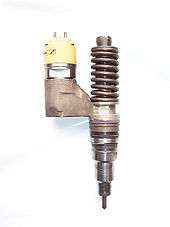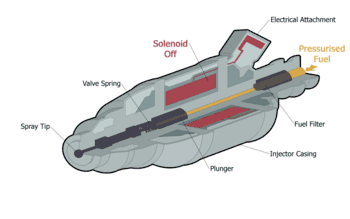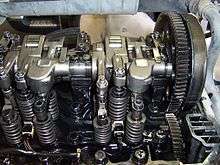Unit injector
A Unit injector (UI) is a high pressure integrated direct fuel injection system for diesel engines, combining the injector nozzle and the injection pump in a single component. The plunger pump used is usually driven by a shared camshaft. In a unit injector, the device is usually lubricated and cooled by the fuel itself.

High pressure injection delivers power and fuel consumption benefits over earlier lower pressure fuel injection by injecting fuel as a larger number of smaller droplets, giving a much higher ratio of surface area to volume. This provides improved vaporization from the surface of the fuel droplets and so more efficient combining of atmospheric oxygen with vaporized fuel, delivering more complete and cleaner combustion.
History
In 1911, a patent was issued in Great Britain for a unit injector resembling those in use today to Frederick Lamplough.[1]
Unit injector system: optimal pressure in each cylinder The unit injector system is an electronically controlled system developed by Bosch for diesel direct injection. It is suitable for cars and light commercial vehicles with up to 5 l engine capacity and 312 hp engine power, the first installation in series production cars was 1998.
.jpg)
Commercial usage of unit injectors in the U.S. began in early 1930s on Winton engines powering locomotives, boats, even US Navy submarines,[2] and in 1934, Arthur Fielden was granted U.S. patent No.1,981,913[3] on the unit injector design[4] later used for the General Motors two-stroke diesel engines. Most mid-sized diesel engines used a single pump and separate injectors, but some makers, such as Detroit Diesel[5] and Electro-Motive Diesel became well known for favoring unit injectors, in which the high-pressure pump is contained within the injector itself. E.W. Kettering's 1951 ASME presentation goes into detail about the development of the modern Unit injector.[6] Also Cummins PT (pressure-time) is a form of unit injection where the fuel injectors are on a common rail fed by a low pressure pump and the injectors are actuated by a third lobe on the camshaft. The pressure determines how much fuel the injectors get and the time is determined by the cam.
In 1994, Robert Bosch GmbH supplied the first electronic unit injector for commercial vehicles, and other manufacturers soon followed. In 1995, Electro-Motive Diesel converted its 710 diesel engines to electronic fuel injection, using an EUI which replaces the UI.
Today, major manufacturers include Robert Bosch GmbH, CAT,[7] Cummins,[8] Delphi,[9][10] Detroit Diesel, Electro-Motive Diesel.[11]
Design and technology
Design of the unit injector eliminates the need for high-pressure fuel pipes, and with that their associated failures, as well as allowing for much higher injection pressure to occur. The unit injector system allows accurate injection timing, and amount control as in the common rail system .[12]
The unit injector is fitted into the engine cylinder head, where the fuel is supplied via integral ducts machined directly into the cylinder head. Each injector has its own pumping element, and in the case of electronic control, a fuel solenoid valve as well. The fuel system is divided into the low pressure (<500 kPa) fuel supply system, and the high-pressure injection system (<2000 bar).[13]
Technical characteristics
The special feature of the unit injector system is that an individual pump is assigned to each cylinder
The pump and nozzle are therefore combined in a compact assembly which is installed directly in the cylinder head
The unit injector system enables high injection pressures up to 2,200 bar.
Advantages
High performance for clean and powerful engine
High engine power balanced against low consumption and low engine emissions
High degree of efficiency due to compact design
Low noise level due to direct assembly in the engine block
Injection pressures up to 2,200 bar for the ideal combination of air-fuel mixture.
Operation principle


The basic operation can be described as a sequence of four separate phases: the filling phase, the spill phase, the injection phase, and the pressure reduction phase.
A low pressure fuel delivery pump supplies filtered diesel fuel into the cylinder head fuel ducts, and into each injector fuel port of constant stroke pump plunger injector, which is overhead camshaft operated.
- Fill phase
- The constant stroke pump element on the way up draws fuel from the supply duct in to the chamber, and as long as electric solenoid valve remains de-energized fuel line is open.
- Spill phase
- The pump element is on the way down, and as long as solenoid valve remains de-energized the fuel line is open and fuel flows in through into the return duct.
- Injection phase
- The pump element is still on the way down, the solenoid is now energized and fuel line is now closed. The fuel can not pass back into return duct, and is now compressed by the plunger until pressure exceeds specific "opening" pressure, and the injector nozzle needle lifts, allowing fuel to be injected into the combustion chamber.
- Pressure reduction phase
- The plunger is still on its way down, the engine ECU de-energizes the solenoid when required quantity of fuel is delivered, the fuel valve opens, fuel can flow back into return duct, causing pressure drop, which in turn causes the injector nozzle needle to shut, hence no more fuel is injected.
- Summary
- The start of an injection is controlled by the solenoid closing point, and the injected fuel quantity is determined by the closing time, which is the length of time the solenoid remains closed. The solenoid operation is fully controlled by the engine ECU.
Additional functions
The use of electronic control allows for special functions; such as temperature controlled injection timing, cylinder balancing (smooth idle), switching off individual cylinders under part load for further reduction in emissions and fuel consumption, and multi-pulse injection (more than one injection occurrence during one engine cycle).
Hydraulically actuated electronic (HEUI) development and applications
In 1993, CAT and International Truck & Engine Corporation[14] introduced "hydraulically actuated electronic unit injection" (HEUI), where the injectors are no longer camshaft-operated and could pressurize fuel independently from engine RPM. First available on Navistar's 7.3L /444 cuin, V8 diesel engine. HEUI uses engine oil pressure to power high-pressure fuel injection, where usual method of unit injector operation is the engine camshaft.
HEUI applications included the Ford 7.3L and 6.0L Powerstroke used between May 1993 and 2007. International also used the HEUI system for multiple engines including the DT 466E, DT 570, T-444E, DT-466–570, MaxxForce 5, 7, 9, 10, MaxxForce DT and VT365 engines. Caterpillar incorporated HEUI systems in the 3116, 3126, 3406e, C7 ACERT, C9 ACERT among others and the Daimler-Detroit Diesel Series 40 engine supplied by International also incorporated a HEUI fuel system.[14]
Unit injector fuel systems are being used on wide variety of vehicles and engines; commercial vehicle from manufacturers such as Volvo, Cummins, Detroit Diesel, CAT, Navistar International and passenger vehicles from manufacturers such as Land Rover and Volkswagen Group, among others, and locomotives from Electro-Motive Diesel.
The Volkswagen Group mainstream marques used unit injector systems (branded "Pumpe Düse",[15] commonly abbreviated to "PD") in their Suction Diesel Injection (SDI) and Turbocharged Direct Injection (TDI) diesel engines,[16] however this fuel injection method has been superseded by a common-rail design, such as the new 1.6 TDI.
In North America, the Volkswagen Jetta, Golf, and New Beetle TDI 2004–2006 are Pumpe Düse[17] (available in both the MK4 and MK5 generations, with BEW and BRM engine codes respectively, older models use timing belt driven injection pump).
Volkswagen Group major-interest truck and diesel engine maker Scania AB also use the unit injector system, which they call "Pumpe-Düse-Einspritzung", or "PDE".
HEUI system has been replaced by many manufacturers with common rail injection solutions newer technology to meet better economy and new emissions standards being introduced.
See also
Notes
- DeLuca, Frank. "History of fuel injection" (PDF). www.disa.it. Retrieved 28 November 2009.
- "The Winton 201A Diesel Engine". Archived from the original on 26 June 2009. Retrieved 28 November 2009.
- "United States Patent 1981913". Retrieved 28 November 2009.
- "A. Fielden Fuel Pump" (PDF). Retrieved 28 November 2009.
- Asmus, A; Wellington B. Diesel Engines and Fuel System. ISBN 1-56091-542-0.
- Kettering, E.W. (29 November 1951). History and Development of the 567 Series General Motors Locomotive Engine. ASME 1951 Annual Meeting. Atlantic City, New Jersey: Electro-Motive Division, General Motors Corporation.
- "HEUI Fuel Systems" (PDF). Cat.com. Caterpillar Inc. 1999. Retrieved 4 November 2009.
- "Fuel Systems - High Pressure Injection (HPI) Systems". Cummins.com. Cummins Inc. Retrieved 29 April 2015.
- "Injection Systems and Components - Delphi E1 Diesel Electronic Unit Injector". Delphi.com. Delphi Automotive LLP. - Manufacturer Products : Commercial Vehicle Industry. Archived from the original on 30 December 2009. Retrieved 4 November 2009.
- "Injection Systems and Components - Delphi E3 Diesel Electronic Unit Injector". Delphi.com. Delphi Automotive LLP. - Manufacturer Products : Commercial Vehicle Industry. Retrieved 4 November 2009.
- "Denso targets French, US automakers". Europe.autonews.com. 2005-10-17. Retrieved 2018-07-08.
- "Pumpe Düse Einspritzung (PDE - UIS)". kfztech.de (in German). Retrieved 15 September 2009.
- "The efficient pump injector unit". BoschAutoParts.co.uk. Robert Bosch GmbH - Automotive. Archived from the original on 2009-03-31. Retrieved 2008-09-30.
- "Archived copy". Archived from the original on 2017-12-11. Retrieved 2018-04-18.CS1 maint: archived copy as title (link)
- "1.9 litre TDI engine with Pump Düse" (PDF). Auburn Hills, MI 48326, USA: Volkswagen of America, Inc. October 2003. Self-Study Program - Course Number 841303. Retrieved 4 November 2009. Cite journal requires
|journal=(help)CS1 maint: location (link) - "Passenger-car systems - Unit Injector System (UIS)". Bosch.de. Robert Bosch GmbH - Automotive Technology - Diesel systems. Archived from the original on 29 October 2009. Retrieved 4 November 2009.
- "Volkswagen Mk4 turbodiesel "how to" index, for 2004–2005 Jettas and 2004–2006 New Beetles and Golfs".
References
- Diesel Fuel Injection published by Robert Bosch GmbH, 1994 ISBN 1-56091-542-0
- Diesel Engines and Fuel Systems by A. Asmus & B. Wellington, 1988 ISBN 0-7299-0013-4